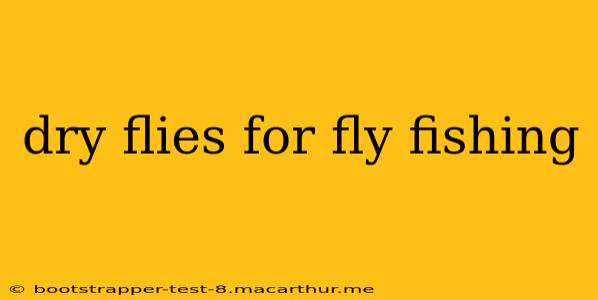Dry fly fishing, the art of presenting a fly that floats on the surface, is a captivating pursuit. The subtle dance of a dry fly, mimicking a naturally drifting insect, can elicit explosive takes from trout and other fish. Understanding the intricacies of dry flies – their design, selection, and presentation – is crucial to success. This guide delves into the world of dry flies, covering everything from basic patterns to advanced techniques.
What are Dry Flies?
Dry flies are artificial flies designed to imitate insects that live on or near the surface of the water. Unlike wet flies, which are fished submerged, dry flies float, offering a highly visible and enticing presentation to feeding fish. Their buoyancy is crucial; a poorly floating fly will rarely entice a strike. The construction utilizes materials that naturally repel water, such as feathers, furs, and synthetic materials, carefully tied to create a lifelike representation.
Different Types of Dry Flies
Dry flies come in a vast array of patterns, each designed to mimic a specific insect. Some popular categories include:
- Mayflies (Ephemeroptera): These delicate insects are a staple of many trout diets. Dry fly patterns imitating mayflies often feature translucent wings and slender bodies. Popular examples include the Adams, the Parachute Adams, and various spent-wing patterns.
- Caddisflies (Trichoptera): Caddisflies are often found clinging to rocks or vegetation near the water's edge. Dry fly patterns representing caddisflies frequently incorporate fuzzy bodies and muted colors. Examples include the Elk Hair Caddis and the Stimulator.
- Ants (Hymenoptera): Ants are readily available terrestrial insects that often fall onto the water's surface. Dry fly patterns imitating ants usually have dark bodies and short legs.
- Grasshoppers (Orthoptera): Larger terrestrial insects like grasshoppers provide substantial meals for trout. These patterns are usually larger and bulkier than other dry fly patterns.
How to Choose the Right Dry Fly
Selecting the appropriate dry fly depends on several factors:
- Matching the Hatch: Observing the insects on and around the water (the "hatch") is paramount. Identify the type of insect, its size, and its behavior to choose a matching fly.
- Water Conditions: The water's clarity, current speed, and temperature can influence fly selection. In clear water, subtle and accurate imitations are crucial; in faster currents, more durable and visible patterns might be necessary.
- Fish Behavior: The way the fish are feeding (rising to the surface or selectively feeding on specific insects) dictates the type of dry fly and its presentation.
How to Use Dry Flies Effectively
Effective dry fly fishing involves several key techniques:
- Proper Presentation: A delicate cast that lands the fly gently on the water's surface is essential. Avoid splashing or disturbing the water.
- Mending the Line: Mending your line helps to keep the fly drifting naturally, avoiding unnatural drag.
- Detecting Strikes: Keep a close eye on the fly and your line. A subtle tug or movement often indicates a strike.
What are the best dry flies for beginners?
For beginners, simple and effective patterns are ideal. The Adams, Royal Wulff, and Elk Hair Caddis are excellent starting points due to their versatility and ease of use. They are readily available in various sizes and colors. Focusing on mastering the fundamental casting and presentation techniques is more important than having an extensive fly box initially.
How do I make my dry flies float better?
Using a dry fly floatant is crucial. Applying a thin layer of floatant to the fly before each cast helps repel water and maintain buoyancy. Floats come in various forms—liquid, powder, or gel—each with its own advantages and disadvantages. Experiment to find what works best for you.
What are some common mistakes when using dry flies?
Common mistakes include:
- Poor casting technique: Uncontrolled casts can scare fish away.
- Incorrect line management: Dragging the line can prevent the fly from drifting naturally.
- Not using floatant: A wet fly won't catch surface-feeding fish.
- Ignoring the hatch: Matching the hatch significantly improves chances of success.
Dry fly fishing is a rewarding experience. With practice, patience, and a keen eye for detail, you can master this challenging yet captivating aspect of fly fishing. Remember that continuous learning and observation are key to improving your skills and enjoying countless successful days on the water.
